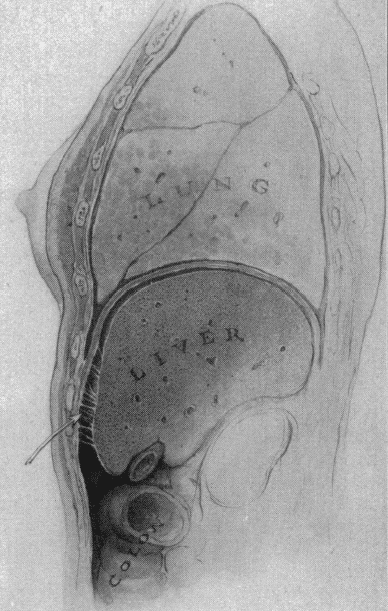Fitz-Hugh Curtis syndrome
Description
Fitz-Hugh-Curtis syndrome refers to perihepatitic adhesions between the liver capsule and under surface of the anterior abdominal wall seen on laparotomy/laparoscopy.
The condition most commonly (but not exclusively) occurs in females with pelvic inflammatory disease/salpingitis infected with Chlamydia trachomatis or Neisseria gonorrhoeae the commonly defined causative organisms.
History
1919 – The Uruguayan surgeon Carlos Stajno (1891-1976) first described a syndrome with characteristic adhesions between the liver capsule and the anterior abdominal corresponding to presenting pain symptoms in a paper read before the Society of Obstetrics and Gynecology of Montevideo, Uruguay. The clinical features of the acute stage of the disease were completely and graphically depicted. However, very little of his work, printed in Spanish and French, was widely circulated in the United States (and is very hard to locate now…)
1930 – Arthur Hale Curtis (1881 – 1955) called attention to the frequent coexistence of gonococcic salpingitis and “violin string” adhesions between the anterior surface of the liver and the anterior abdominal wall discovered at at laparotomy in patients with atypical gallbladder symptoms – conditions indicating, presumably, a chronic, healing or healed perihepatitis. He believed that the adhesions were indicative of gonococcal infection
Extensive adhesions between the anterior surface of the liver and the anterior abdominal wall, characteristically of the separate “violin-string” type, are not infrequently encountered in patients operated on for relief of pelvic distress incident to gonorrheal disease of the tubes. It would appear that gonorrheal disease is not so invariably limited to the pelvis as has heretofore been assumed. Female patients with symptoms suggestive of gallbladder disease or pleurisy may be suffering from liver-abdominal wall adhesions complicating a pelvic gonorrheal infection.
Curtis 1930

1934 – Thomas Fitz-Hugh Jr (1894 – 1963) published the cases of 3 women presenting with pain in the right upper quadrant abdominal pain due to adhesions between the liver and abdominal wall, which he attributed to acute gonococcal peritonitis. He postulated this as the forerunner of the violin-string adhesions previously described by Curtis.
After cogitating overnight we decided that what we had seen was probably the acute stage of the process described in its chronic form by Curtis. Accordingly, smears were made from the drainage tract and we were promptly rewarded with the finding of a beautiful spread of typical Gram-negative intracellular biscuit-shaped diplococci’
Fitz-Hugh 1934
To aid in future clinical diagnosis Fitz-Hugh described some of the pertinent clinical finding:
The anterior abdominal wall below the right costal border is rigid and exquisitely sensitive. A crunching to and fro type of friction may be readily heard just over this area of the abdominal wall, at least during the subsiding stage of the acute process….Her [Case 3] contribution to this syndrome, beautiful “new snow” creaking frictions audible all along the right upper margin of the anterior abdominal wall, is perhaps of considerable importance.
Fitz-Hugh 1934
Fitz-Hugh summarised the clinical and pathological findings:
In three cases of what is believed to be acute gonococcic peritonitis of the right upper quadrant in young women, the clinical and pathologic features are sufficiently distinct and uniform to justify the belief that the diagnosis may sometimes be made without great difficulty. These cases, which represent the acute stage, help to complete the picture of the condition the end stage of which has been described by Curtis as “violin-string” adhesions between the anterior surface of the liver and the anterior abdominal wall occurring in women with present gonorrheal salpingitis or a previous history of that condition.
Fitz-Hugh 1934
1946 – The condition became known as Fitz-Hugh Curtis syndrome or gonococcal perihepatitis. Malcolm M Stanley reported on three patients successfully treated with penicillin and defined the condition named as either the “Phrenic Reaction; Subcostal Syndrome of Stajano; or Fitz-Hugh—Curtis Syndrome.”
1970 – Kimball and Knee (1970) and Francis and Osoba (1972) described gonococcal perihepatitis in males with gonococcal urethritis, reducing the likelihood of the tubal ostia being the primary focus of spread
1978 – Müller-Schoop (1978) proposed Chlamydia trachomatis as an aetiological agent, confirmed by Wang (1980) and Wølner-Hanssen (1980).
2003 – Sharma (2003) has also proposed genital tuberculosis as a potential cause of the typical perihepatitic adhesions.
Associated Persons
- Thomas Fitz-Hugh Jr (1894-1963)
- Arthur Hale Curtis (1881-1955)
Alternative names
- Fitz-Hugh and Curtis syndrome; Fitz-Hugh-Curtis syndrome
- Curtis Fitz-Hugh syndrome
- Gonococcal perihepatitis
- Subcostal Syndrome of Stajano
References
- Stajano C. La reacción frénica en ginecología. La semana médica, Buenos Aires. 1920; 27: 243-248.
- Curtis AH. A cause of adhesions in the right upper quadrant. JAMA. 1930; 94(16): 1221-1222.
- Fitz-Hugh T Jr. Acute gonococcic peritonitis of the right upper quadrant in women. JAMA. 1934; 102(25): 2094-2096.
- Fitz-Hugh T Jr. Acute gonococcic perihepatitis – a new syndrome of right upper quadrant abdominal pain in young women. Review of gastroenterology. 1936; 3: 125–131.
- Stanley MM. Gonococcic peritonitis of the upper part of abdomen in young women. Arch Intern Med (Chic). 1946;78:1-13.
- Kimball MW, Knee S. Gonococcal perihepatitis in a male. The Fitz-Hugh Curtis syndrome. N Engl J Med. 1970; 282(19): 1082-4.
- Francis TI, Osoba AO. Gonococcal hepatitis (Fitz-Hugh Curtis syndrome) in a male patient. Br J Vener Dis. 1972; 48(3): 187–188.
- Müller-Schoop JW, Wang SP et al. Chlamydia trachomatis as possible cause of peritonitis and perihepatitis in young women. Br Med J 1978;1:1022-1024
- Wang SP et al. Chlamydia trachomatis infection in Fitz-Hugh-Curtis syndrome. Am J Obstet Gynecol. 1980; 138(7: 2): 1034-8
- Wølner-Hanssen P, Weström L, Mårdh PA. Perihepatitis and chlamydial salpingitis. Lancet. 1980; 1(8174): 901-3.
- Sharma JB, Malhotra M, Arora R. Fitz-Hugh-Curtis syndrome as a result of genital tuberculosis: a report of three cases. Acta Obstet Gynecol Scand. 2003;82(3):295-297.
- MacLean AB. Fitz-hugh-curtis syndrome. J Obstet Gynaecol. 2008; 28(3): 259-260.
- Ricci P, Lema R, Solá V, et al. Fitz-Hugh-Curtis syndrome: Three cases of incidental diagnosis during laparoscopy. J Obstet Gynaecol. 2008; 28(3):352-354.
eponymictionary
the names behind the name
Doctor in Australia. Keen interest in internal medicine, medical education, and medical history.
